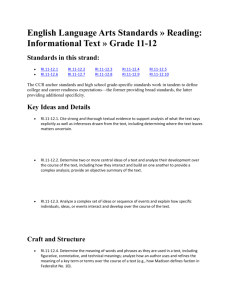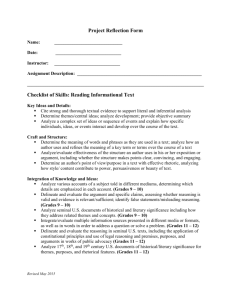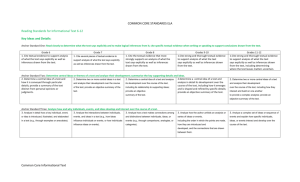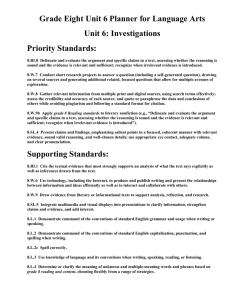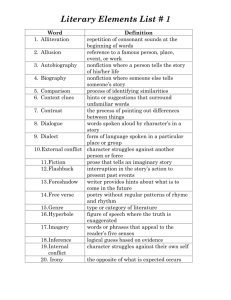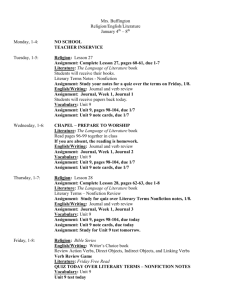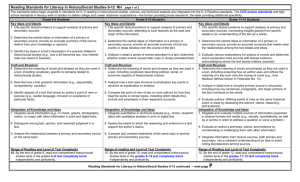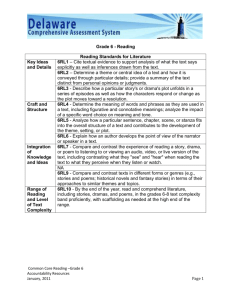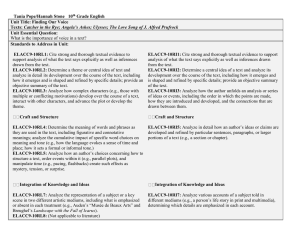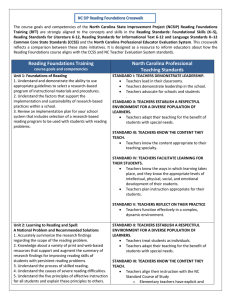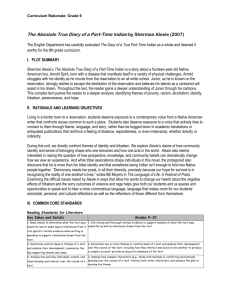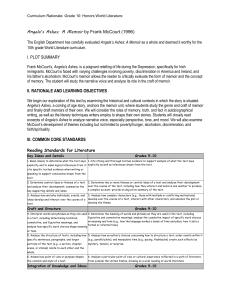9-12 - Erlanger-Elsmere Schools
advertisement
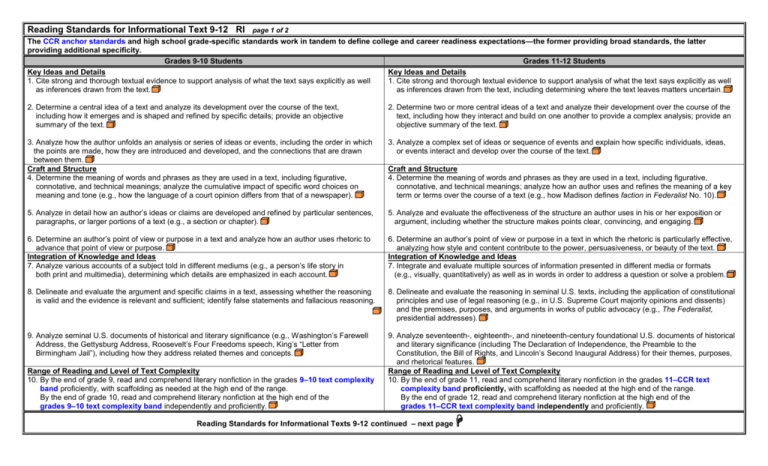
Reading Standards for Informational Text 9-12 RI page 1 of 2 The CCR anchor standards and high school grade-specific standards work in tandem to define college and career readiness expectations—the former providing broad standards, the latter providing additional specificity. Grades 9-10 Students Grades 11-12 Students Key Ideas and Details Key Ideas and Details 1. Cite strong and thorough textual evidence to support analysis of what the text says explicitly as well 1. Cite strong and thorough textual evidence to support analysis of what the text says explicitly as well as inferences drawn from the text. as inferences drawn from the text, including determining where the text leaves matters uncertain. 2. Determine a central idea of a text and analyze its development over the course of the text, including how it emerges and is shaped and refined by specific details; provide an objective summary of the text. 2. Determine two or more central ideas of a text and analyze their development over the course of the text, including how they interact and build on one another to provide a complex analysis; provide an objective summary of the text. 3. Analyze how the author unfolds an analysis or series of ideas or events, including the order in which the points are made, how they are introduced and developed, and the connections that are drawn between them. Craft and Structure 4. Determine the meaning of words and phrases as they are used in a text, including figurative, connotative, and technical meanings; analyze the cumulative impact of specific word choices on meaning and tone (e.g., how the language of a court opinion differs from that of a newspaper). 3. Analyze a complex set of ideas or sequence of events and explain how specific individuals, ideas, or events interact and develop over the course of the text. 5. Analyze in detail how an author’s ideas or claims are developed and refined by particular sentences, paragraphs, or larger portions of a text (e.g., a section or chapter). 5. Analyze and evaluate the effectiveness of the structure an author uses in his or her exposition or argument, including whether the structure makes points clear, convincing, and engaging. 6. Determine an author’s point of view or purpose in a text and analyze how an author uses rhetoric to advance that point of view or purpose. Integration of Knowledge and Ideas 7. Analyze various accounts of a subject told in different mediums (e.g., a person’s life story in both print and multimedia), determining which details are emphasized in each account. 6. Determine an author’s point of view or purpose in a text in which the rhetoric is particularly effective, analyzing how style and content contribute to the power, persuasiveness, or beauty of the text. Integration of Knowledge and Ideas 7. Integrate and evaluate multiple sources of information presented in different media or formats (e.g., visually, quantitatively) as well as in words in order to address a question or solve a problem. 8. Delineate and evaluate the argument and specific claims in a text, assessing whether the reasoning is valid and the evidence is relevant and sufficient; identify false statements and fallacious reasoning. 8. Delineate and evaluate the reasoning in seminal U.S. texts, including the application of constitutional principles and use of legal reasoning (e.g., in U.S. Supreme Court majority opinions and dissents) and the premises, purposes, and arguments in works of public advocacy (e.g., The Federalist, presidential addresses). 9. Analyze seminal U.S. documents of historical and literary significance (e.g., Washington’s Farewell Address, the Gettysburg Address, Roosevelt’s Four Freedoms speech, King’s “Letter from Birmingham Jail”), including how they address related themes and concepts. 9. Analyze seventeenth-, eighteenth-, and nineteenth-century foundational U.S. documents of historical and literary significance (including The Declaration of Independence, the Preamble to the Constitution, the Bill of Rights, and Lincoln’s Second Inaugural Address) for their themes, purposes, and rhetorical features. Range of Reading and Level of Text Complexity 10. By the end of grade 11, read and comprehend literary nonfiction in the grades 11–CCR text complexity band proficiently, with scaffolding as needed at the high end of the range. By the end of grade 12, read and comprehend literary nonfiction at the high end of the grades 11–CCR text complexity band independently and proficiently. Range of Reading and Level of Text Complexity 10. By the end of grade 9, read and comprehend literary nonfiction in the grades 9–10 text complexity band proficiently, with scaffolding as needed at the high end of the range. By the end of grade 10, read and comprehend literary nonfiction at the high end of the grades 9–10 text complexity band independently and proficiently. Craft and Structure 4. Determine the meaning of words and phrases as they are used in a text, including figurative, connotative, and technical meanings; analyze how an author uses and refines the meaning of a key term or terms over the course of a text (e.g., how Madison defines faction in Federalist No. 10). Reading Standards for Informational Texts 9-12 continued – next page Reading Standards for Informational Text 9-12 RI Informational Text Continuum 9 - 12 K-2 3-5 6-8 Depth of Knowledge DOK 1 DOK 2 DOK 3 DOK 4 page 2 of 2 Program of Studies Transformations Reading 1.2 2.24 2.25 Communication Skills 1.3 1.4 1.12 Problem Solving Skills 5.1 5.2 5.3 5.4 5.5 Con. & Integrating Knowledge 6.1 6.2 6.3 Resources Bloom’s Taxonomy Bloom’s & William’s Taxonomy CPE’s NAEP Distributions in Reading & Writing Core Standards Glossary High School Vocabulary WEB Resources Kentucky Department of Education US Department of Education Core Standards International Reading Association National Council of Teachers of English Lexiles
